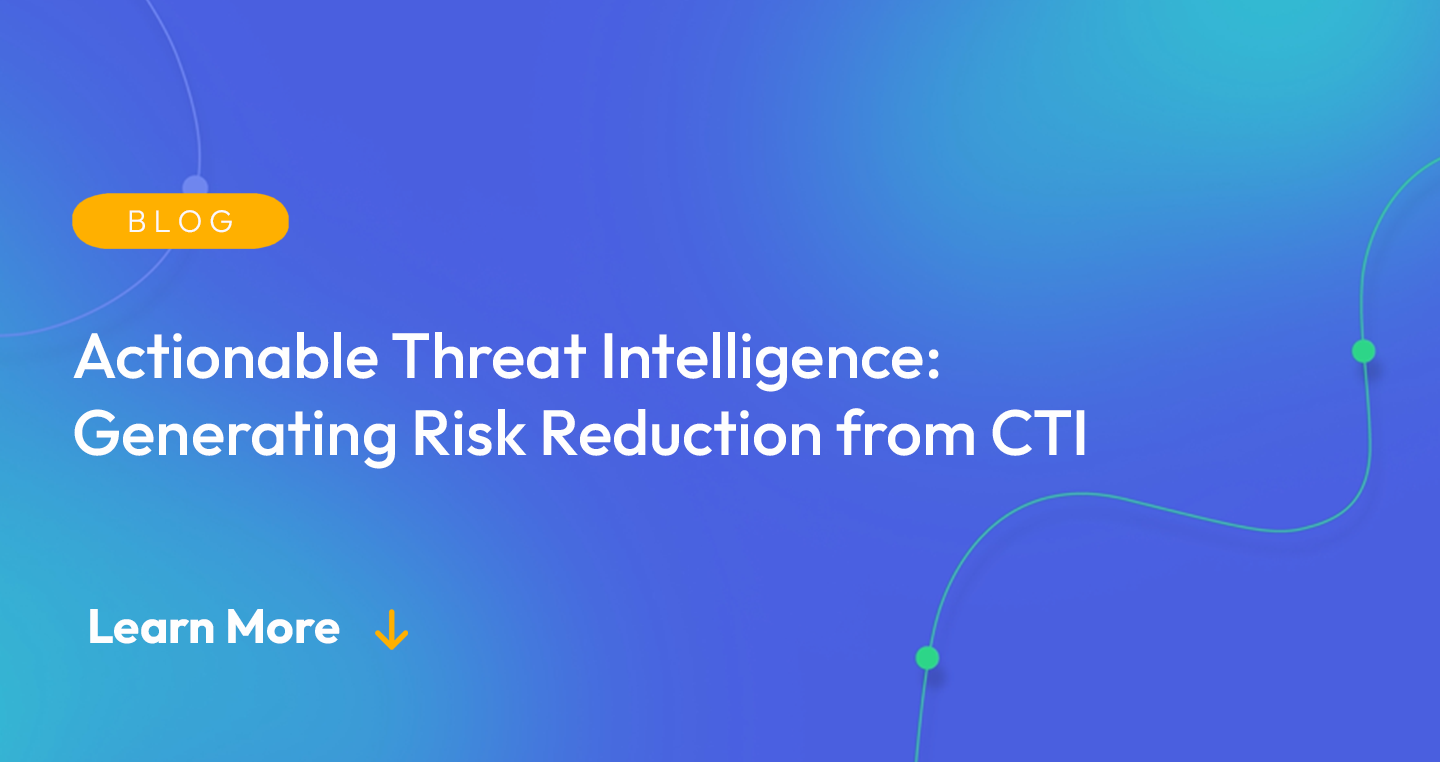
Organizations need to go beyond traditional security measures to effectively protect their valuable assets and maintain a strong security posture. They must harness the power of actionable threat intelligence, which provides timely and relevant insights that can drive proactive risk reduction strategies.
Actionable threat intelligence empowers organizations to not only understand the threat landscape but also take informed and targeted actions to mitigate risks and defend against potential cyber attacks.
Actionable Threat Intelligence: The Value
Organizations face an increasing number of sophisticated and persistent threats. To effectively mitigate these risks and protect their digital assets, organizations need more than just raw threat data—they need actionable threat intelligence. Actionable threat intelligence refers to the insights and information derived from cyber threat intelligence (CTI) that can be directly applied to enhance security measures and reduce risk.
What Does Actionable Threat Intelligence Provide?
Actionable threat intelligence provides organizations with specific, relevant, and timely information about:
- Emerging threats
- Attack techniques
- Indicators of compromise (IOCs)
Unlike generic threat data, actionable threat intelligence goes beyond mere awareness and equips organizations with the knowledge needed to proactively defend against threats. By leveraging actionable threat intelligence, organizations can make informed decisions, prioritize resources, and implement effective security controls to reduce their overall risk exposure.
The value of actionable threat intelligence lies in its ability to enable organizations to be proactive rather than reactive in their security posture. Instead of waiting for an attack to occur, organizations can leverage actionable threat intelligence to identify potential vulnerabilities, anticipate attack patterns, and implement proactive security measures.
This proactive approach not only reduces the likelihood of successful attacks but also minimizes the impact of potential breaches, allowing organizations to effectively manage risks and protect their critical assets.
Moreover, actionable threat intelligence provides organizations with a deeper understanding of the threat landscape and the motivations, tactics, and techniques employed by threat actors. This contextual understanding allows organizations to prioritize their security efforts, allocate resources effectively, and tailor their defensive strategies to the specific threats they face. By focusing on the most relevant and imminent threats, organizations can optimize their risk mitigation efforts and minimize the strain on their resources.
Actionable Threat Intelligence and Cross-Organizational Decision-Making
Actionable threat intelligence also facilitates informed decision-making at various levels within an organization. Security teams can use this intelligence to fine-tune their incident response plans, prioritize vulnerability patching, and enhance their security controls. Business leaders can leverage actionable threat intelligence to assess the potential impact of cyber threats on their operations, make strategic investments in security measures, and demonstrate due diligence to stakeholders.
Actionable threat intelligence is a valuable asset for organizations seeking to strengthen their cybersecurity defenses and reduce risk. By providing specific and relevant insights into emerging threats, actionable threat intelligence empowers organizations to proactively identify and mitigate potential risks. This proactive approach allows organizations to stay ahead of attackers, optimize resource allocation, and make informed decisions that effectively protect their digital assets.
Components of an Effective CTI Program
To generate actionable threat intelligence and effectively reduce risks, organizations need to establish a robust cyber threat intelligence (CTI) program. An effective CTI program comprises several key components that work together to collect, analyze, and disseminate valuable threat intelligence. Let’s explore these components in detail:
Comprehensive Data Collection
The foundation of any CTI program is the collection of comprehensive and diverse data from multiple sources. This includes external threat intelligence feeds, internal logs, open source intelligence, dark web monitoring, and information sharing communities. By gathering a wide range of data, organizations can gain a holistic view of the threat landscape and identify emerging threats.
Threat Analysis and Contextualization
Once the data is collected, it needs to be analyzed and contextualized to derive meaningful insights. This involves conducting in-depth analysis, using threat intelligence platforms, machine learning algorithms, and human expertise to identify patterns, indicators of compromise (IOCs), and potential attack vectors. Contextualization helps understand the motivations, techniques, and capabilities of threat actors, enabling organizations to prioritize their defenses.
Intelligence Reporting and Sharing
The actionable threat intelligence generated through analysis should be shared effectively across the organization and with relevant stakeholders. This involves creating intelligence reports that are concise, relevant, and easy to understand.
Reports can include IOCs, attack narratives, recommended mitigation strategies, and strategic insights. Sharing this intelligence with key decision-makers, security teams, and incident response teams ensures that everyone is informed and able to take appropriate actions.
Collaboration and Information Sharing
Collaboration with trusted partners, industry peers, and information sharing communities is a crucial component of an effective CTI program. By participating in collaborative platforms and sharing information, organizations can benefit from the collective intelligence of the cybersecurity community.
Collaboration enhances the quality and timeliness of threat intelligence, enables the identification of shared threats, and fosters a proactive security posture.
Integration with Security Infrastructure
To maximize the value of actionable threat intelligence, it should be seamlessly integrated into an organization’s security infrastructure. This involves integrating threat intelligence feeds with security information and event management (SIEM) systems, intrusion detection and prevention systems (IDS/IPS), and other security tools. Integration allows for real-time threat detection, automated response, and improved decision-making based on the latest threat intelligence.
Continuous Monitoring and Evaluation
An effective CTI program requires continuous monitoring and evaluation to ensure its relevance and effectiveness. This includes monitoring changes in the threat landscape, tracking the performance of intelligence sources, evaluating the impact of threat intelligence on risk reduction, and seeking feedback from stakeholders. By regularly reviewing and improving the CTI program, organizations can adapt to evolving threats and optimize their intelligence-driven security strategies.
By incorporating these components into their CTI program, organizations can generate actionable threat intelligence that drives risk reduction efforts. The combination of comprehensive data collection, thorough analysis, effective reporting and sharing, collaboration, integration with security infrastructure, and continuous evaluation forms a holistic approach to leveraging CTI for proactive defense against cyber threats.
Leveraging Actionable Threat Intelligence for Risk Reduction
Actionable threat intelligence is a vital component of a proactive cybersecurity strategy. It empowers organizations to identify, mitigate, and respond to potential threats before they can cause significant harm. By leveraging actionable threat intelligence generated from their CTI program, organizations can effectively reduce risks and enhance their overall security posture.
Let’s explore how organizations can harness the power of actionable threat intelligence to drive risk reduction efforts:
Proactive Threat Detection
Actionable threat intelligence enables organizations to proactively detect threats in their environments. By analyzing the indicators of compromise (IOCs) and patterns identified through threat intelligence, security teams can identify potential threats and vulnerabilities before they are exploited.
This proactive approach allows organizations to take preventive measures, such as patching vulnerabilities, updating security configurations, or implementing additional security controls to mitigate the identified risks.
Timely Incident Response
With actionable threat intelligence, organizations can respond swiftly and effectively to security incidents. By integrating threat intelligence feeds into their incident response processes, organizations can automatically correlate real-time threat data with ongoing incidents. This integration helps prioritize and escalate incidents based on the severity and relevance of the threat intelligence, enabling faster response times and minimizing the impact of security breaches.
Enhanced Vulnerability Management
Actionable threat intelligence provides valuable insights into known vulnerabilities and emerging threats. By aligning threat intelligence with vulnerability management programs, organizations can prioritize patching and remediation efforts based on the risk posed by specific vulnerabilities. This targeted approach ensures that limited resources are allocated to address the most critical vulnerabilities, reducing the attack surface and strengthening the overall security posture.
Strategic Decision-Making
Actionable threat intelligence equips organizations with the knowledge to make informed and strategic decisions regarding their security investments and resource allocation. By understanding the threat landscape, organizations can identify emerging trends, anticipate potential risks, and allocate resources to areas that are most susceptible to attacks. This strategic decision-making based on actionable threat intelligence helps optimize security investments and allocate resources effectively to minimize risk exposure.
Threat Hunting and Proactive Defense
Actionable threat intelligence enables organizations to engage in proactive threat hunting activities. By leveraging threat intelligence feeds, security teams can actively search for:
- Indicators of compromise
- Signs of unauthorized access
- Other suspicious activities within their environments
This proactive defense approach allows organizations to detect and respond to threats that may have bypassed traditional security controls, enhancing their ability to prevent successful attacks.
Continuous Improvement
Actionable threat intelligence plays a crucial role in a cycle of continuous improvement. By analyzing the effectiveness of threat intelligence in risk reduction efforts, organizations can refine their CTI program, update their intelligence sources, and fine-tune their analysis techniques. This ongoing evaluation and improvement ensure that organizations stay ahead of evolving threats and remain resilient in the face of new attack vectors.
By leveraging actionable threat intelligence, organizations can proactively identify, mitigate, and respond to cyber threats, resulting in significant risk reduction. The integration of threat intelligence into various security processes enables organizations to detect threats early, respond swiftly, and make informed decisions to enhance their overall security posture.
Best Practices for Maximizing the Impact of CTI on Risk Mitigation
Implementing a robust cyber threat intelligence (CTI) program is a crucial step in enhancing an organization’s security posture. However, to maximize the impact of CTI on risk mitigation, organizations must follow best practices that ensure the effective utilization of actionable threat intelligence.
Let’s explore seven key practices that can help organizations extract the most value from their CTI program and generate significant risk reduction:
1. Clearly Define Objectives and Requirements
Before implementing a CTI program, organizations should clearly define their objectives and requirements. This includes identifying the specific threats and risks they want to address, determining the desired outcomes, and understanding the information needs of different stakeholders.
By having a well-defined strategy, organizations can focus their CTI efforts on areas that align with their overall risk mitigation goals.
2. Establish Comprehensive Data Collection
To generate actionable threat intelligence, organizations must establish comprehensive data collection processes. This involves collecting data from a variety of internal and external sources, such as:
- Security logs
- Threat feeds
- Open source intelligence
- Dark web monitoring
By casting a wide net and gathering diverse data, organizations can enhance their visibility into the threat landscape and identify potential risks more effectively.
3. Emphasize Contextual Analysis
Contextual analysis is essential for deriving actionable insights from threat intelligence. Organizations should invest in advanced analysis techniques and technologies that enable them to contextualize the collected data. This includes mapping threat indicators to relevant campaigns, threat actors, and attack techniques.
By understanding the context in which threats operate, organizations can better prioritize their mitigation efforts and respond appropriately to the most critical risks.
4. Foster Collaboration and Information Sharing
Collaboration and information sharing are key elements in maximizing the impact of CTI on risk mitigation. Organizations should actively engage with trusted partners, industry peers, and information sharing communities to exchange threat intelligence and gain additional perspectives.
Collaborative efforts allow organizations to leverage the collective knowledge and experiences of others, broaden their understanding of emerging threats, and enhance their overall threat detection and response capabilities.
5. Integrate CTI into Security Operations
To derive the most value from CTI, organizations should integrate it into their security operations. This involves incorporating actionable threat intelligence feeds into security tools, such as SIEM (Security Information and Event Management) systems, intrusion detection systems, and endpoint protection solutions.
By integrating CTI into existing security infrastructure, organizations can automate threat detection and response processes, enabling faster and more effective risk mitigation.
6. Regularly Update and Refine CTI Processes
Threat landscapes are constantly evolving, and organizations must keep their CTI processes up to date. Regularly review and refine the CTI program to ensure its relevance and effectiveness. This includes updating intelligence sources, refining analysis techniques, and incorporating feedback from stakeholders. By continuously improving CTI processes, organizations can adapt to emerging threats and maintain an agile defense posture.
7. Foster a Culture of Continuous Learning
Maximizing the impact of CTI requires fostering a culture of continuous learning within the organization. Encourage security teams to stay updated on the latest threat trends, attend industry conferences and training programs, and engage in ongoing professional development.
By nurturing a learning mindset, organizations can ensure that their CTI program remains cutting-edge and that security personnel are equipped with the necessary knowledge and skills to effectively leverage actionable threat intelligence.
By following these best practices, organizations can optimize the impact of their CTI program on risk mitigation. Clear objectives, comprehensive data collection, contextual analysis, collaboration, integration into security operations, regular updates, and a culture of continuous learning are all critical components of a successful CTI program. By harnessing actionable threat intelligence and implementing these practices, organizations can significantly reduce their risk exposure and enhance their overall security posture.
Actionable Threat Intelligence with Flare
To secure their invaluable assets and strengthen their defense mechanisms, organizations must push past the boundaries of conventional security practices. They should leverage the potential of practical cyber threat intelligence, offering them vital, up-to-the-minute insights that facilitate preemptive risk management tactics.
Flare monitors for external risks across billions of data points and thousands of sources across the clear & dark web and Telegram. Your security team can take in this vast amount of information without all the noise, to act quickly to stop threats. Start your free trial today to learn more.





